Locational Dynamics of Luxury Hotels in Shanghai Metropolis, China: A Spatial-Temporal Perspective
Abstract
:1. Introduction
2. Literature Review
2.1. Luxury Hotel Location Models
2.2. Factors Influencing the Location Distribution of Luxury Hotels
3. Methods and Data
3.1. Study Area
3.2. Spatial Statistics Approaches
3.2.1. Exploratory Spatial Analysis Tools
3.2.2. MGWR Model
3.3. Data and Variables
4. Results
4.1. Luxury Hotel Development Trend in Shanghai City
4.2. Geo-Spatial Pattern Analysis
4.3. Spatial Autocorrelation Analysis
5. Factors of Luxury Hotel Location
6. Conclusions and Discussion
Author Contributions
Funding
Institutional Review Board Statement
Informed Consent Statement
Data Availability Statement
Conflicts of Interest
References
- Kim, J.; Okamoto, N. Importance analysis on hotel components from a manager’s perspective: Using conjoint analysis. Asia Pac. J. Tour. Res. 2006, 11, 227–238. [Google Scholar] [CrossRef]
- Adam, I.; Amuquandoh, F.E. Dimensions of hotel location in the Kumasi Metropolis, Ghana. Tour. Manag. Perspect. 2013, 8, 1–8. [Google Scholar] [CrossRef]
- Yang, Y.; Roehl, W.S.; Huang, J.H. Understanding and projecting the restaurant scape: The influence of neighborhood sociodemographic characteristics on restaurant location. Int. J. Hosp. Manag. 2017, 67, 33–45. [Google Scholar] [CrossRef]
- Lockyer, T. Understanding the dynamics of the hotel accommodation pur-chase decision. Int. J. Contemp. Hosp. Manag. 2005, 17, 481–492. [Google Scholar] [CrossRef]
- Lim, C.; Loh, S. Gen Y consumers’ perceptions of quick service restaurant andthe mediating role of purchase intentions–A case study of McDonald’s inSingapore. Eur. J. Tour. Res. 2014, 7, 31–44. [Google Scholar] [CrossRef]
- Sainaghi, R. RevPAR determinants of individual hotels: Evidences from Milan. Int. J. Contemp. Hosp. Manag. 2011, 23, 297–311. [Google Scholar] [CrossRef]
- Haghighi, M.; Dorosti, A.; Rahnama, A.; Hoseinpour, A. Evaluation of factorsaffecting customer loyalty in the restaurant industry. Afr. J. Bus. Manag. 2012, 6, 5039–5046. [Google Scholar]
- Ahmadi-Javid, A.; Seyedi, P.; Syam, S.S. A survey of healthcare facility location. Comput. Oper. Res. 2017, 79, 223–263. [Google Scholar] [CrossRef]
- Urtasun, A.; Gutiérrez, I. Hotel location in tourism cities: Madrid 1936–1998. Ann. Tour. Res. 2006, 33, 382–402. [Google Scholar] [CrossRef]
- Luo, H.; Yang, Y. Intra-metropolitan location choice of star-rated and non-rated budget hotels: The role of agglomeration economies. Int. J. Hosp. Manag. 2016, 59, 72–83. [Google Scholar] [CrossRef]
- Rogerson, J.M. The changing location of hotels in South Africa’s coastal cities, 1990–2010. Urban Forum 2012, 23, 73–91. [Google Scholar] [CrossRef]
- Yang, Y.; Luo, H.; Law, R. Theoretical, empirical, and operational models in hotel location research. Int. J. Hosp. Manag. 2014, 36, 209–220. [Google Scholar] [CrossRef]
- Roginsky, R.J. A critical analysis of hotel impact issues. Cornell Hotel. Adm. Q. 1995, 13, 12–19. [Google Scholar] [CrossRef]
- Egan, D.J.; Nield, K. Towards a theory of intraurban hotel location. Urban Stud. 2000, 37, 611–621. [Google Scholar] [CrossRef]
- Shoval, N. The geography of hotels in cities: An empirical validation of a forgotten model. Tour. Geogr. 2006, 8, 56–75. [Google Scholar] [CrossRef]
- Kalnins, A.; Chung, W. Resource-seeking agglomeration: A study of market entry in the lodging industry. Strateg. Manag. J. 2004, 25, 689–699. [Google Scholar] [CrossRef]
- Baum, J.A.C.; Haveman, H.A. Love thy neighbor? Differentiation and agglomeration in the Manhattan hotel industry, 1898–1990. Adm. Sci. Q. 1997, 42, 304–338. [Google Scholar] [CrossRef]
- Bloomfield, G.T. Lodging at the interchange in London, Ontario. Can. Geogr. 1996, 40, 173–180. [Google Scholar] [CrossRef]
- Holl, A. Transport infrastructure, agglomeration economies, and firm birth: Empirical evidence from Portugal. J. Reg. Sci. 2004, 44, 693–712. [Google Scholar] [CrossRef]
- Yang, Y.; Wong, K.K.F.; Wang, T. How do hotels choose their location? Evidence from hotels in Beijing. Int. J. Hosp. Manag. 2012, 31, 675–685. [Google Scholar] [CrossRef]
- Yang, Y.; Tang, J.; Luo, H.; Law, R. Hotel location evaluation: A combination of machine learning tools and web GIS. Int. J. Hosp. Manag. 2015, 47, 14–24. [Google Scholar] [CrossRef]
- Tarras, J. Location, location, location. Restaur. Hosp. 1991, 75, 84. [Google Scholar]
- Roehl, W.S.; Van Doren, C.S. Locational characteristics of American resort hotels. J. Cult. Geogr. 1990, 11, 71–83. [Google Scholar] [CrossRef]
- Alias, A.; Tan, S.B. Key determinants for marketing and operational strategies of hotel business. J. Surv. Constr. Prop. 2014, 5, 1–7. [Google Scholar] [CrossRef]
- Yang, Z.; Cai, J. Do regional factors matter? Determinants of hotel industry performance in China. Tour. Manag. 2016, 52, 242–253. [Google Scholar] [CrossRef]
- Luo, H.; Yang, Y. Spatial pattern of hotel distribution in China. Tour. Hosp. Res. 2013, 13, 3–15. [Google Scholar] [CrossRef]
- Yue, L.; Zhao, H.; Xu, X.; Gu, T.; Jia, Z. Quantifying the Spatial Fragmentation Pattern and Its Influencing Factors of Urban Land Use: A Case Study of Pingdingshan City, China. Land 2022, 11, 686. [Google Scholar] [CrossRef]
- Lao, X.; Gu, H.; Yu, H.; Xiao, F. Exploring the Spatially-Varying Effects of Human Capital on Urban Innovation in China. Appl. Spat. Anal. Policy 2021, 14, 827–848. [Google Scholar] [CrossRef]
- Alcácer, J.; Chung, W. Location strategies for agglomeration economies. Strateg. Manag. J. 2014, 35, 1749–1761. [Google Scholar] [CrossRef]
- Canina, L.; Enz, C.A.; Harrison, J.S. Agglomeration effects and strategic orientations: Evidence from the U.S. lodging industry. Acad. Manag. J. 2005, 148, 565–581. [Google Scholar] [CrossRef]
- Enz, C.A.; Canina, L.; Liu, Z. Competitive dynamics and pricing behavior in UShotels: The role of co-location. Scand. J. Hosp. Tour. 2008, 8, 230–250. [Google Scholar] [CrossRef]
- Ingram, P.; Inman, C. Institutions, intergroup competition, and the evolution of hotel populations around Niagara falls. Adm. Sci. Q. 1996, 41, 629–658. [Google Scholar] [CrossRef]
- Arauzo-Carod, J.-M.; Liviano-Solis, D.; Manjón-Antolín, M. Empirical studiesin industrial location: An assessment of their methods and results. J. Reg. Sci. 2010, 50, 685–711. [Google Scholar] [CrossRef]
- Guimarães, P.; Figueiredo, O.; Woodward, D. Industrial location modeling: Extending the random utility framework. J. Reg. Sci. 2004, 44, 1–20. [Google Scholar] [CrossRef]
- Li, M.; Fang, L.; Huang, X.; Goh, C. A spatial-temporal analysis of hotels in urban tourism destination. Int. J. Hosp. Manag. 2015, 45, 34–43. [Google Scholar] [CrossRef]
- Zhang, H.; Zhang, J.; Lu, S.; Cheng, S. Modeling hotel room price with geographically weighted regression. Int. J. Hosp. Manag. 2011, 30, 1036–1043. [Google Scholar] [CrossRef]
- Pan, F.C. Practical application of importance-performance analysis in determining critical job satisfaction factors of a tourist hotel. Tour. Manag. 2015, 46, 84–91. [Google Scholar] [CrossRef]
- Prayag, G.; Hosany, S. Human resource development in the hotel industry of Mauritius: Myth or reality? Curr. Issues Tour. 2015, 18, 249–266. [Google Scholar] [CrossRef]
- Newell, G.; Seabrook, R. Factors influencing hotel investment decision making. J. Prop. Investig. Financ. 2006, 24, 279–294. [Google Scholar] [CrossRef]
- Sainaghi, R.; Baggio, R. Structural social capital and hotel performance: Is there a link? Int. J. Hosp. Manag. 2014, 37, 99–110. [Google Scholar] [CrossRef]
- Lin, B.-H.; Liu, H.-H. A study of economies of scale and economies of scope in Taiwan international tourist hotels. Asia Pac. J. Tour. Res. 2000, 5, 21–28. [Google Scholar] [CrossRef]
- Lee, M.J.; Jang, S. Market diversification and financial performance and stability: A study of hotel companies. Int. J. Hosp. Manag. 2007, 26, 362–375. [Google Scholar] [CrossRef]
- Nieves, J.; Segarra-Ciprés, M. Management innovation in the hotel industry. Tour. Manag. 2015, 46, 51–58. [Google Scholar] [CrossRef]
- Xiao, Q.; O’Neill, J.W.; Mattila, A.S. The role of hotel owners: The influence of corporate strategies on hotel performance. Int. J. Contemp. Hosp. Manag. 2012, 24, 122–139. [Google Scholar] [CrossRef]
- Assaf, A.G.; Josiassen, A.; Agbola, F.W. Attracting international hotels: Locational factors that matter most. Tour. Manag. 2015, 47, 329–340. [Google Scholar] [CrossRef]
- Parte-Esteban, L.; Alberca-Oliver, P. Determinants of technical efficiency in the Spanish hotel industry: Regional and corporate performance factors. Curr. Issues Tour. 2013, 18, 391–411. [Google Scholar] [CrossRef]
- Johnson, C.; Vanetti, M. Locational strategies of international hotel chains. Ann. Tour. Res. 2005, 32, 1077–1099. [Google Scholar] [CrossRef]
- Dwyer, L.; Forsyth, P. Impacts and benefits of mice tourism: A framework for analysis. Tour. Econ. 1997, 3, 21–38. [Google Scholar] [CrossRef]
- Lee, C.; Taylor, T. Critical reflections on the economic impact assessment of a mega-event: The case of 2002 FIFA World Cup. Tour. Manag. 2005, 26, 595–603. [Google Scholar] [CrossRef]
- Malfas, M.; Theodoraki, E.; Houlihan, B. Impacts of the Olympic games as mega-events. Munic. Eng. 2004, 157, 209–220. [Google Scholar] [CrossRef]
- Zhang, H.Q.; Guillet, B.D.; Gao, W. What determines multinational hotel groups’ locational investment choice in China? Int. J. Hosp. Manag. 2012, 31, 350–359. [Google Scholar] [CrossRef]
- Wall, G.; Dudycha, D.; Hutchinson, J. Point pattern analyses of accommodation in Toronto. Ann. Tour. Res. 1985, 12, 603–618. [Google Scholar] [CrossRef]
- Adam, I. Urban hotel development patterns in the Kumasi Metropolis, Ghana. Tour. Plan. Dev. 2013, 10, 85–98. [Google Scholar] [CrossRef]
- Rigall-I-Torrent, R.; Fluvià, M. Public goods in tourism municipalities: Formal analysis, empirical evidence and implications for sustainable development. Tour. Econ. 2007, 13, 361–378. [Google Scholar] [CrossRef]
- Rigall-I-Torrent, R.; Fluvià, M. Managing tourism products and destinations embedding public good components: A hedonic approach. Tour. Manag. 2011, 32, 244–255. [Google Scholar] [CrossRef]
- Barros, C.P. Evaluating the efficiency of a small hotel chain with a Malmquist productivity index. Int. J. Tour. Res. 2005, 7, 173–184. [Google Scholar] [CrossRef]
- Zheng, T. What caused the decrease in RevPAR during the recession? An ARIMA with intervention analysis of room supply and market demand. Int. J. Contemp. Hosp. Manag. 2014, 26, 1225–1242. [Google Scholar] [CrossRef]
- Assaf, A.G.; Josiassen, A.; Woo, L.; Agbola, F.W.; Tsionas, M. Destination characteristics that drive hotel performance: A state-of-the-art global analysis. Tour. Manag. 2017, 60, 270–279. [Google Scholar] [CrossRef]
- Bégin, S. The geography of a tourist business: Hotel distribution and urban development in Xiamen, China. Tour. Geogr. 2000, 2, 448–471. [Google Scholar] [CrossRef]
- Shoval, N.; Cohen-Hattab, K. Urban hotel development patterns in the face of political shifts. Ann. Tour. Res. 2001, 28, 908–925. [Google Scholar] [CrossRef]
- Oppermann, M.; Din, K.; Amri, S.Z. Urban hotel location and evolution in a developing country: The case of Kuala Lumpur, Malaysia. Tour. Recreat. Res. 1996, 21, 55–63. [Google Scholar] [CrossRef]
- Freedman, M.L.; Kosová, R. Agglomeration, product heterogeneity and firmentry. J. Econ. Geogr. 2012, 12, 601–626. [Google Scholar] [CrossRef]
- Egan, D.J.; Chen, W.; Zhang, Y. The intra-urban location of hotels in the Chinese cities of Beijing, Shanghai & Shenzhen. China Tour. Res. 2006, 2, 516–530. [Google Scholar]
- Awaritefe, O.D. Evaluating tourism resource areas in Nigeria for development. Tour. Rev. 2007, 62, 37–45. [Google Scholar] [CrossRef]
- Islam, M. Spatial Distribution of Market Centers. Int. Res. J. Bus. Stud. 2018, 10, 135–146. [Google Scholar] [CrossRef]
- Anselin, L. Specification tests on the structure of interaction in spatial econometric models. Pap. Reg. Sci. 1984, 54, 165–182. [Google Scholar] [CrossRef]
- Anselin, L. Local indicator of spatial association-lisa. Geogr. Anal. 1995, 27, 91–115. [Google Scholar] [CrossRef]
- Gu, H.; Yu, H.; Sachdeva, M.; Liu, Y. Analyzing the distribution of researchers in China: An approach using multiscale geographically weighted regression. Growth Chang. 2020, 52, 443–459. [Google Scholar] [CrossRef]
- Lao, X.; Gu, H. Unveiling various spatial patterns of determinants of hukou transfer intentions in China: A multi-scale geographically weighted regression approach. Growth Chang. 2020, 51, 1860–1876. [Google Scholar] [CrossRef]
- Leonidou, L.C.; Leonidou, C.N.; Fotiadis, T.A.; Zeriti, A. Resources and capabilities as drivers of hotel environmental marketing strategy: Implications for competitive advantage and performance. Tour. Manag. 2013, 35, 94–110. [Google Scholar] [CrossRef]
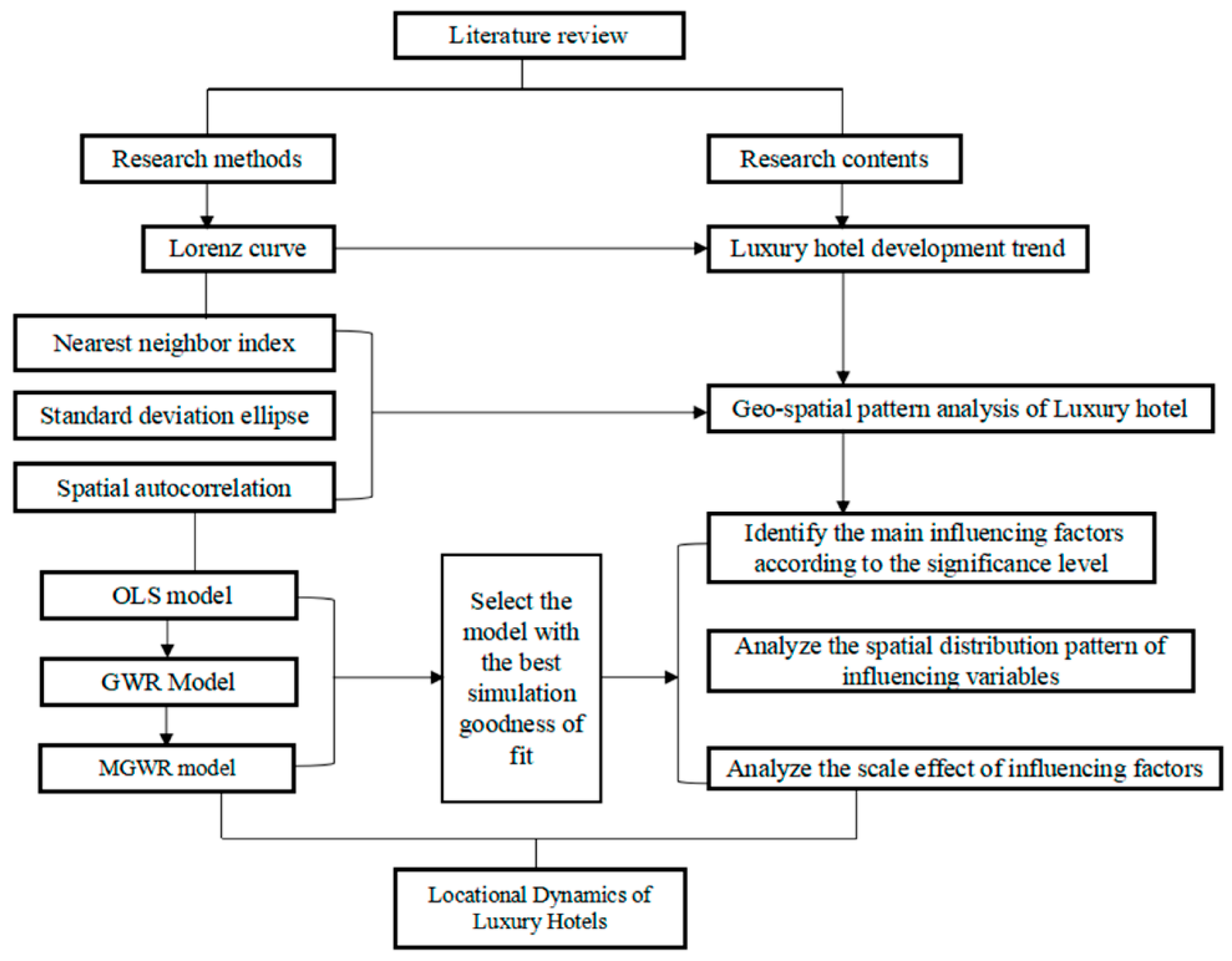
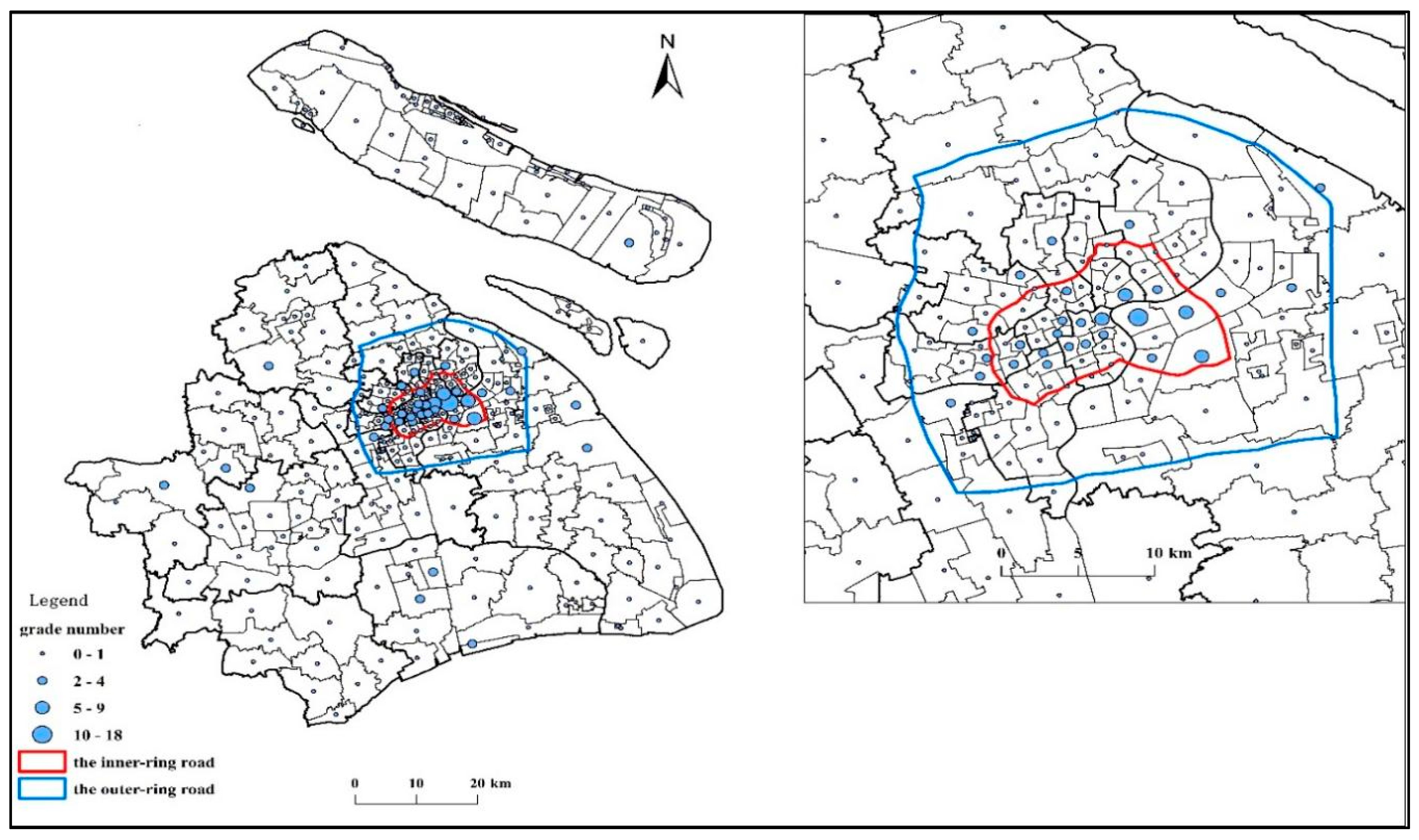

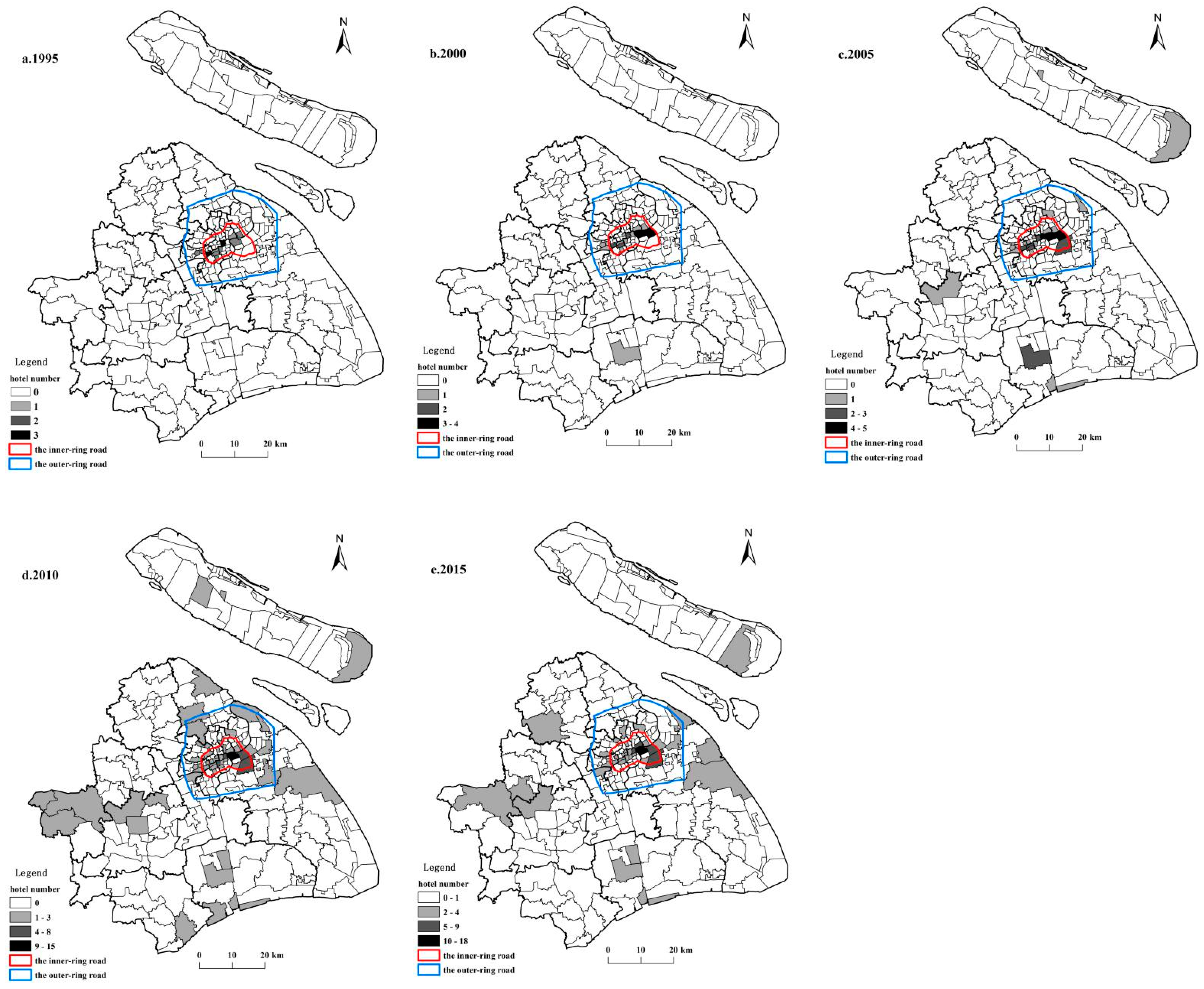
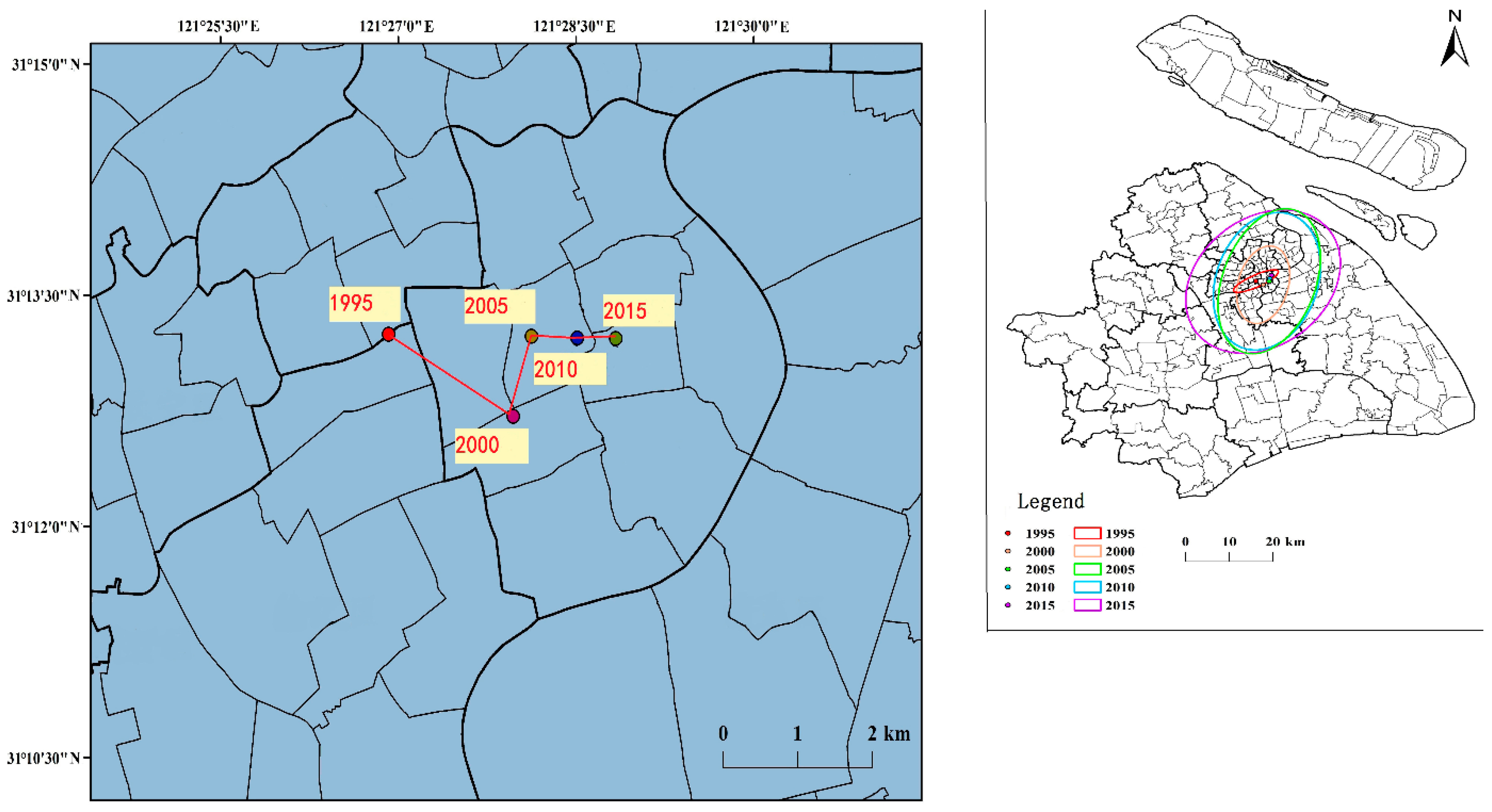
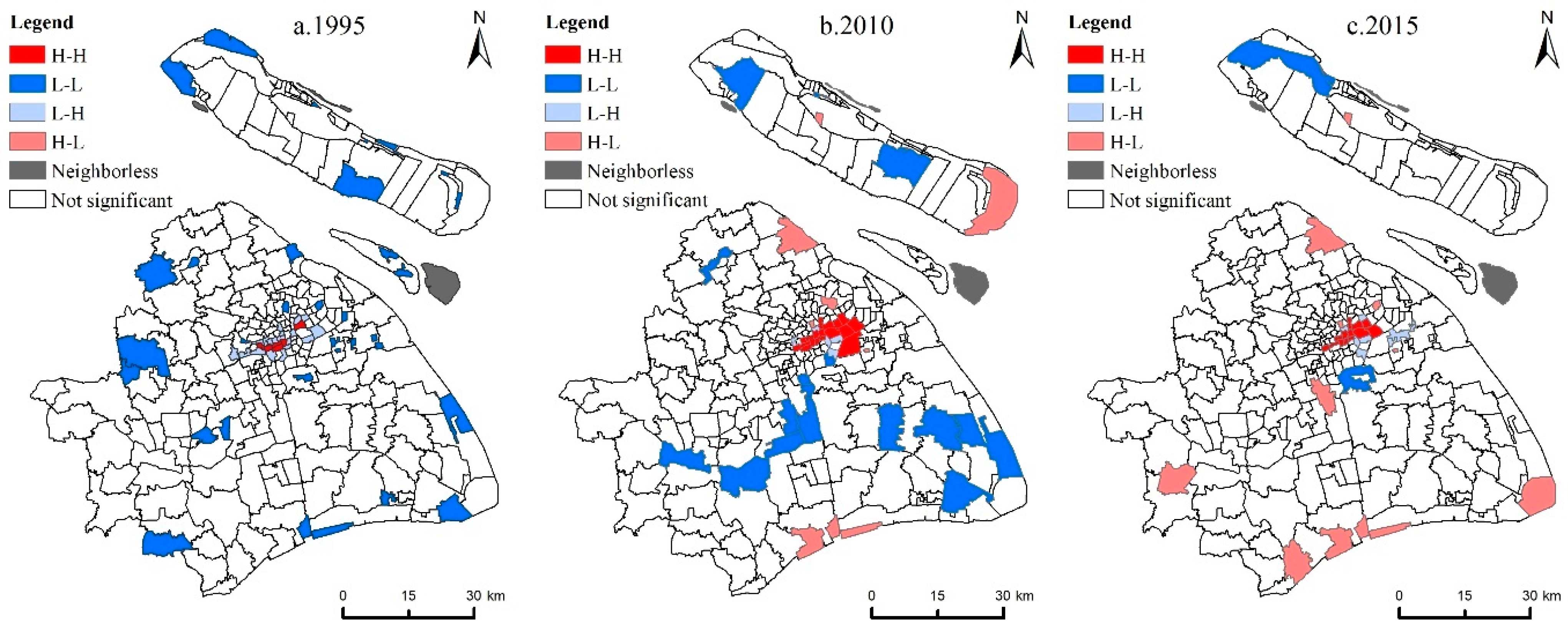
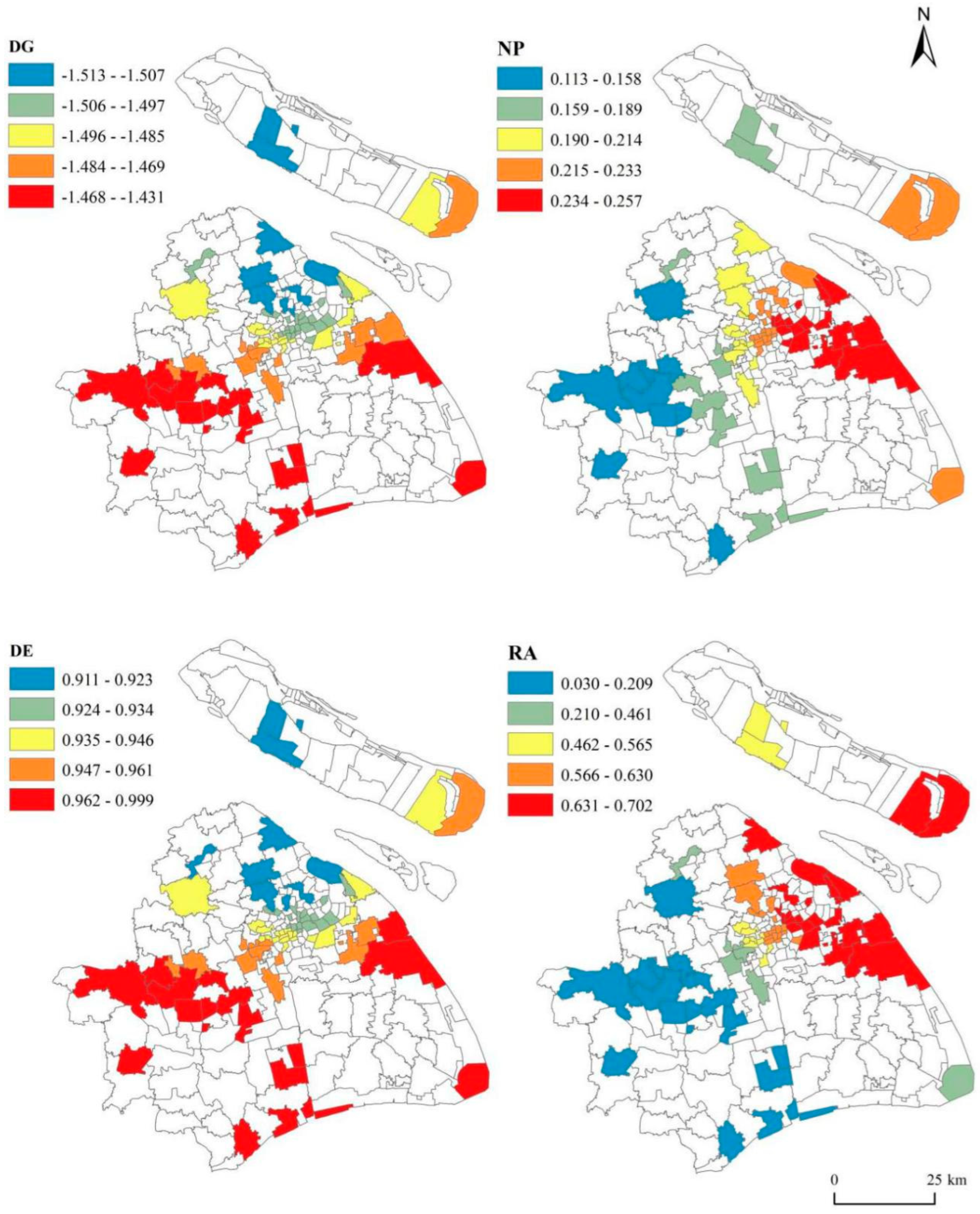

| Indicators | Measurement | Unite |
|---|---|---|
| Transportation accessibility | Number of subway stations in each zone (NS) | Number |
| Distance to the nearest airport (DA) | Km | |
| Market demand | Distance to the nearest financial center (DFC) | Km |
| Business environment | Distance to the nearest business center (CBD) | Km |
| Room rate (RA) | Yuan | |
| Institutional proximity | Distance to municipal government (DG) | Km |
| Green space | Number of parks in each zone (NP) | Number |
| Mega events | Distance to the World Expo (DE) | Km |
| Year of Opening | Number of Luxury Hotels | Percent | Total Number of Rooms | Percent |
|---|---|---|---|---|
| Before 1995 | 13 | 8.13 | 4624 | 9.56 |
| 1995–2000 | 11 | 6.88 | 4660 | 9.64 |
| 2001–2005 | 19 | 11.87 | 7041 | 14.56 |
| 2006–2010 | 74 | 46.25 | 20,924 | 43.28 |
| 2010–2015 | 43 | 26.87 | 11,104 | 22.96 |
| Sample | Average Distance to the Nearest Neighbor (m) | Expect Distance to the Nearest Neighbor (m) | The Nearest Neighbor Index | Z-Test Value | Significance Level | |
|---|---|---|---|---|---|---|
| 1995 | 13 | 97 | 103 | 1.01 | −0.37 | Non-significant |
| 2000 | 24 | 186 | 230 | 0.81 | −1.77 | 0.1 |
| 2005 | 43 | 321 | 443 | 0.72 | −3.45 | 0.05 |
| 2010 | 117 | 165 | 329 | 0.49 | −10.31 | 0.01 |
| 2015 | 160 | 171 | 341 | 0.47 | −12.38 | 0.01 |
| Year | Moran’s I Value | p-Value | Z(I)-Score |
|---|---|---|---|
| 1995 | 0.268 | 0.001 | 7.775 |
| 2010 | 0.314 | 0.001 | 9.089 |
| 2015 | 0.452 | 0.001 | 12.76 |
| Variables | Model1: OLS | Model2: GWR | Model3: MGWR | |||||
|---|---|---|---|---|---|---|---|---|
| β | T | β | T | Bandwidths | β | T | Bandwidths | |
| Intercept | 0 | 0 | −0.027 | −0.263 | −0.079 | −0.615 | ||
| DFC | 0.058 | 0.178 | 0.328 | 0.653 | 75 | 0.215 | 0.456 | 75 |
| DA | 0.307 * | 1.422 | 0.277 | 1.224 | 75 | 0.238 | 1.072 | 75 |
| CBD | 0.003 | 0.008 | 0.000 | 0.004 | 75 | −0.052 | −0.138 | 75 |
| DG | −0.424 | −0.685 | −1.206 ** | −1.617 | 75 | −1.488 *** | −2.036 | 75 |
| NP | 0.14 * | 1.373 | 0.213 *** | 1.929 | 75 | 0.208 ** | 1.892 | 73 |
| NS | 0.09 | 0.788 | 0.087 | 0.753 | 75 | 0.087 | 0.777 | 73 |
| DE | −0.032 | −0.053 | 0.481 | 0.700 | 75 | 0.943 * | 1.382 | 75 |
| RA | 0.486 *** | 4.927 | 0.507 *** | 4.945 | 75 | 0.487 *** | 3.908 | 50 |
| AICc | 194.085 | 196.331 | 193.769 | |||||
| R2 | 0.447 | 0.504 | 0.551 | |||||
| Adj.R2 | 0.381 | 0.403 | 0.445 | |||||
Publisher’s Note: MDPI stays neutral with regard to jurisdictional claims in published maps and institutional affiliations. |
© 2022 by the authors. Licensee MDPI, Basel, Switzerland. This article is an open access article distributed under the terms and conditions of the Creative Commons Attribution (CC BY) license (https://creativecommons.org/licenses/by/4.0/).
Share and Cite
Zhao, H.; Gu, T.; Yue, L.; Xu, X. Locational Dynamics of Luxury Hotels in Shanghai Metropolis, China: A Spatial-Temporal Perspective. Land 2022, 11, 1690. https://doi.org/10.3390/land11101690
Zhao H, Gu T, Yue L, Xu X. Locational Dynamics of Luxury Hotels in Shanghai Metropolis, China: A Spatial-Temporal Perspective. Land. 2022; 11(10):1690. https://doi.org/10.3390/land11101690
Chicago/Turabian StyleZhao, Hongbo, Tianshun Gu, Li Yue, and Xiaoman Xu. 2022. "Locational Dynamics of Luxury Hotels in Shanghai Metropolis, China: A Spatial-Temporal Perspective" Land 11, no. 10: 1690. https://doi.org/10.3390/land11101690
APA StyleZhao, H., Gu, T., Yue, L., & Xu, X. (2022). Locational Dynamics of Luxury Hotels in Shanghai Metropolis, China: A Spatial-Temporal Perspective. Land, 11(10), 1690. https://doi.org/10.3390/land11101690








